Dosing designed to fit your needs
Actor portrayal.
GOMEKLI (mirdametinib) comes with a built-in treatment break
GOMEKLI is taken by mouth twice a day (about 12 hours apart).
Each GOMEKLI dosing cycle is 28 days (4 weeks).
GOMEKLI is taken for the first 21 days, followed by 7 days when GOMEKLI is not taken.
The next cycle then begins with 21 days of treatment.
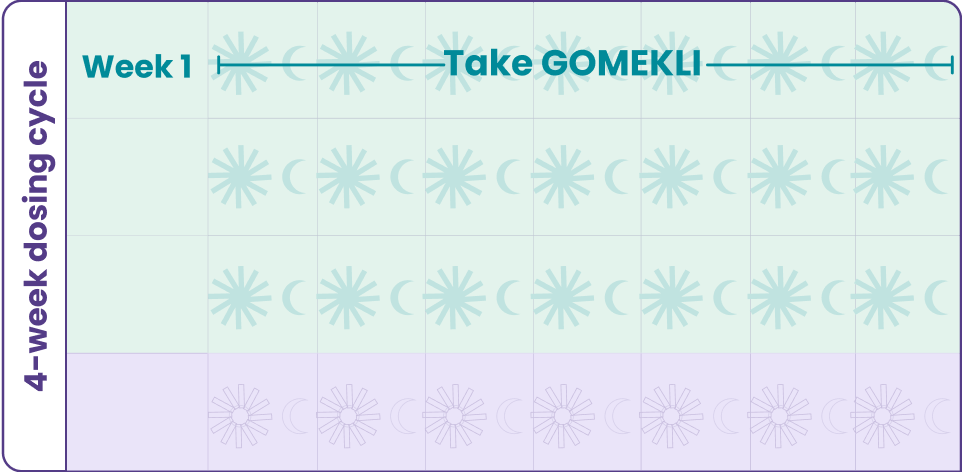
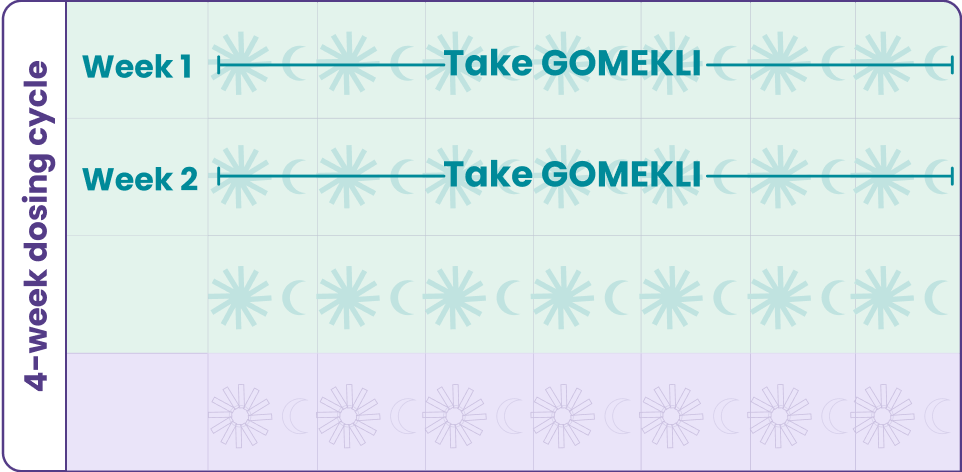
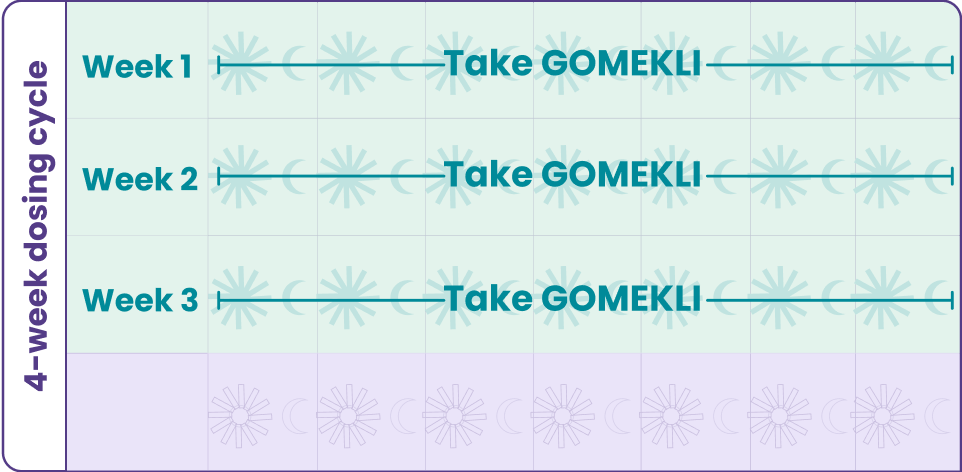

Your healthcare provider will decide the right dose of GOMEKLI based on weight and height (body surface area). It’s important to take GOMEKLI as directed by your healthcare provider.
GOMEKLI comes in two forms
Grape-flavored tablets
for oral suspension
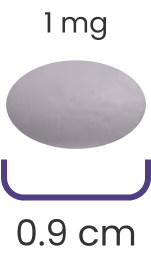
Capsules that come in
two sizes
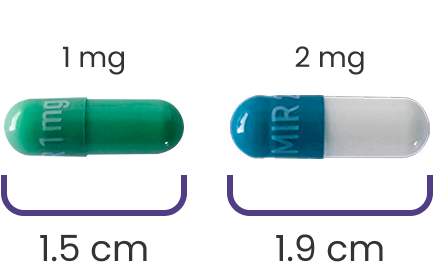


Tic Tac® and its three-dimensional design are registered trademarks of Ferrero S.A.
GOMEKLI can be taken with or without food. No fasting is required
Preparing GOMEKLI tablets for liquid dosing
OR
Getting started guide
Personalized treatment journal
Before starting GOMEKLI treatment
Your healthcare provider may order some tests before and during GOMEKLI treatment, including:
Echocardiogram
to look at the heart
Blood tests
Eye exam
to check your vision and the health of your eyes
Pregnancy test
for people who are able to become pregnant
Before taking GOMEKLI, tell your healthcare provider about all of your medical conditions.

Savings and support
What is GOMEKLI?
GOMEKLI (mirdametinib) is a prescription medicine used to treat adults and children 2 years of age and older with neurofibromatosis type 1 (NF1) who have plexiform neurofibromas that cause symptoms and cannot be completely removed by surgery.
It is not known if GOMEKLI is safe and effective in children under 2 years of age.
Important Safety Information
Before taking GOMEKLI, tell your healthcare provider about all of your medical conditions, including if you:
- Have eye problems
- Have heart problems
- Are pregnant or plan to become pregnant. GOMEKLI can harm your unborn baby
Females who are able to become pregnant:
- Your healthcare provider should check to see if you are pregnant before you begin treatment with GOMEKLI.
- Use effective birth control (contraception) during treatment with GOMEKLI and for 6 weeks after your last dose.
- Tell your healthcare provider right away if you become pregnant or think you may be pregnant during treatment with GOMEKLI.
Males with female partners who are able to become pregnant:
- Use effective birth control (contraception) during treatment with GOMEKLI and for 3 months after your last dose.
- Tell your healthcare provider right away if your female partner becomes pregnant or thinks she may be pregnant during treatment with GOMEKLI.
- Are breastfeeding or plan to breastfeed. It is not known if GOMEKLI passes into your breast milk.
- Do not breastfeed during treatment with GOMEKLI and for 1 week after your last dose.
- Talk to your healthcare provider about the best way to feed your baby during this time.
Tell your healthcare provider about all the medicines you take, including prescription and over-the-counter medicines, vitamins, and herbal supplements.
How should I take GOMEKLI?
- Take GOMEKLI exactly as your healthcare provider tells you to take it. Your healthcare provider may change your dose, temporarily stop, or permanently stop treatment with GOMEKLI if you develop certain side effects.
- Take GOMEKLI twice a day, about 12 hours apart, for 21 days, followed by 7 days off treatment, to complete a 28-day treatment cycle. Your healthcare provider will decide how many treatment cycles are right for you.
- Take GOMEKLI with or without food.
- GOMEKLI comes in two different dosage forms, GOMEKLI capsules and GOMEKLI tablets for oral suspension. Your healthcare provider will decide the dosage form and dose of GOMEKLI that is right for you.
- If you take GOMEKLI capsules: Swallow each capsule whole with drinking water. If more than 1 capsule is required, swallow 1 capsule at a time. Do not open, break or chew the capsules.
- If you take GOMEKLI tablets for oral suspension, either:
- Swallow each tablet for oral suspension whole with drinking water. If more than 1 tablet is required, swallow 1 tablet at a time.
- Disperse the tablets for oral suspension in drinking water to make a liquid (suspension) before you take or give GOMEKLI.
OR
See the “Instructions for Use” that come with your medicine for instructions on how to prepare and take GOMEKLI tablets for oral suspension.
- If you miss a dose of GOMEKLI, skip the missed dose and take your next dose at your regularly scheduled time.
- If you vomit at any time after taking GOMEKLI, do not take an additional dose. Take your next dose at your regularly scheduled time.
What are the possible side effects of GOMEKLI?
- Eye problems. GOMEKLI may cause eye problems that can lead to blindness. Your healthcare provider will check your vision before and during treatment with GOMEKLI. Tell your healthcare provider right away if you get any of the following signs or symptoms of eye problems:
- Blurred vision
- Loss of vision
- Other changes to your vision
- Heart problems. GOMEKLI may lower the amount of blood pumped by your heart, which is common in children during treatment with GOMEKLI and can also be severe. Your healthcare provider will do tests before you start GOMEKLI treatment, every 3 months during your first year of treatment, and then as needed to make sure your heart is working properly. Tell your healthcare provider right away if you get any of the following signs or symptoms of heart problems:
- Coughing or wheezing
- Shortness of breath
- Swelling of your ankles and feet
- Tiredness
- Increased heart rate
- Skin problems. Skin rashes are common with GOMEKLI in both adults and children and can also be severe. GOMEKLI can also cause hair loss (alopecia). Tell your healthcare provider if you develop any of the following signs or symptoms of skin problems:
- Flat skin rash
- Raised bumps on the skin
- Skin bumps that look like acne
- Skin redness
- Itchy rash
- Peeling skin
The most common side effects of GOMEKLI in adults include:
- Diarrhea
- Nausea
- Muscle, joint, and bone pain
- Vomiting
- Tiredness
The most common side effects of GOMEKLI in children include:
- Diarrhea
- Muscle, joint, and bone pain
- Stomach (abdominal) pain
- Vomiting
- Headache
- Skin redness, swelling, or pain around the fingernails or toenails
- Nausea
What is GOMEKLI?
It is not known if GOMEKLI is safe and effective in children under 2 years of age.
Using a dosing cup
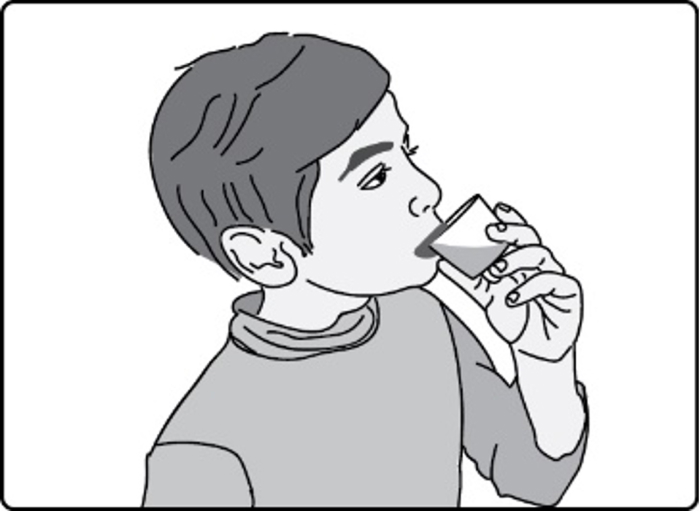
Step 1: Wash and dry your hands before preparing GOMEKLI (mirdametinib) tablets for oral suspension.
Step 2: Add about 5 mL to 10 mL of drinking water to the dosing cup. Note: The amount of water does not need to be exact. Only use water to prepare the dose.
Step 3: Count the prescribed number of tablets into your hand.
Step 4: Add the prescribed number of tablets to the water.
Step 5: Swirl the dosing cup gently to disperse the tablets until no lumps remain. It will take about 2 to 4 minutes to fully disperse the tablets in the water. GOMEKLI oral suspension will be white and cloudy and there will be some medicine (residue) visible. Try not to spill any of the prepared oral suspension.
Important: Take or give GOMEKLI oral suspension right away after preparing the dose. If you cannot take or give it right away, take or give GOMEKLI oral suspension within 30 minutes of preparing the dose.
Step 6: Take or give the GOMEKLI oral suspension from the dosing cup right away after preparing the dose. If more than 30 minutes have passed since you prepared the dose, throw away (dispose of) the GOMEKLI oral suspension and start over from Step 1. If you are not sure how to throw away the GOMEKLI oral suspension, ask your healthcare provider or pharmacist.
Important: After swallowing the oral suspension, there will be some medicine (residue) still inside the dosing cup. The residue may be hard to see. Follow Steps 7 through 9 to make sure that the full dose of GOMEKLI is taken or given.
Step 7: Add another 5 to 10 mL of drinking water to the same dosing cup.
Step 8: Swirl the dosing cup gently.
Step 9: Drink or give the water and residue mixture from the dosing cup.
Step 10: Wash the dosing cup with clean water. Allow the dosing cup to dry completely before storing. Wash your hands when you are finished.
For additional information, please see full Prescribing Information, including Patient Information and Instructions for Use.
Using an oral syringe
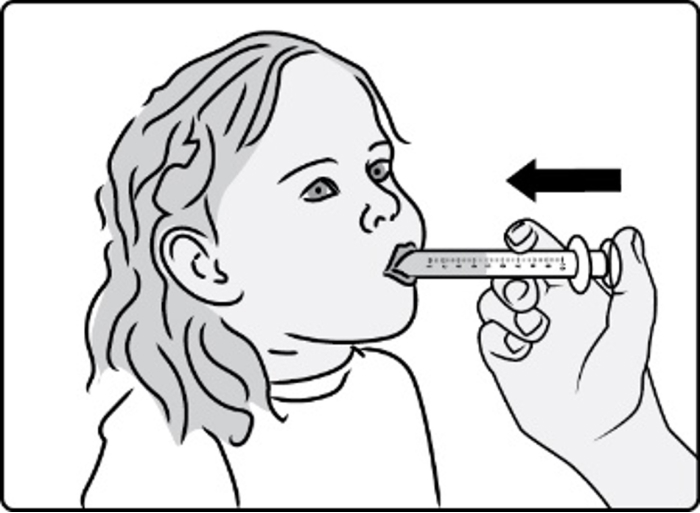
Step 1: Wash and dry your hands before preparing GOMEKLI (mirdametinib) tablets for oral suspension.
Step 2: Add about 5 mL to 10 mL of drinking water to the dosing cup. Note: The amount of water does not need to be exact. Only use water to prepare the dose.
Step 3: Count the prescribed number of tablets into your hand.
Step 4: Add the prescribed number of tablets to the water.
Step 5: Swirl the dosing cup gently to disperse the tablets until no lumps remain. It will take about 2 to 4 minutes to fully disperse the tablets in the water. GOMEKLI oral suspension will be white and cloudy and there will be some medicine (residue) visible. Try not to spill any of the prepared oral suspension.
Important: Take or give GOMEKLI oral suspension right away after preparing the dose. If you cannot take or give it right away, take or give GOMEKLI oral suspension within 30 minutes of preparing the dose.
Step 6: Place the tip (open end) of the oral syringe into the prepared medicine and draw up all the GOMEKLI oral suspension from the dosing cup into the oral syringe by pulling back on the plunger.
Important: Take or give the GOMEKLI oral suspension from the oral syringe right away after preparing the dose. If more than 30 minutes have passed since you prepared the dose, throw away (dispose of) the GOMEKLI oral suspension and start over from Step 1. If you are not sure how to throw away the GOMEKLI oral suspension, ask your healthcare provider or pharmacist.
Step 7: Place the tip of the oral syringe inside the mouth pointing toward the inside of either cheek. If you are giving a dose of GOMEKLI oral suspension to a child, make sure they are sitting upright until all the liquid has been swallowed.
Step 8: Slowly push the plunger all the way down to give the full dose of GOMEKLI. Allow time for all the medicine to be swallowed.
Important: After swallowing the oral suspension, there will be some medicine (residue) still inside the dosing cup and oral syringe. The residue may be hard to see. Follow Steps 9 through 12 to make sure that the full dose of GOMEKLI is given.
Step 9: Add another 5 to 10 mL of drinking water to the same dosing cup.
Step 10: Swirl the dosing cup gently.
Step 11: Place the tip of the oral syringe into the dosing cup and draw the water and residue mixture into the oral syringe by pulling back on the plunger. Take or give all of the water and residue mixture to the child. Allow time for the water and residue mixture to be swallowed.
Step 12: Wash the dosing cup and oral syringe with clean water. Pull the plunger out of the oral syringe and wash the oral syringe parts separately. Allow the parts to dry completely before reassembling and storing. Wash your hands when you are finished.
For additional information, please see full Prescribing Information, including Patient Information and Instructions for Use.
You are now leaving GOMEKLI.com
You are now leaving GOMEKLI.com, a website provided by SpringWorks Therapeutics. This link will take you to a different site to which this Privacy Policy and Terms of Use do not apply.
This site is intended for US Healthcare Professionals
Tap "Continue" if you are a US Healthcare Professional.